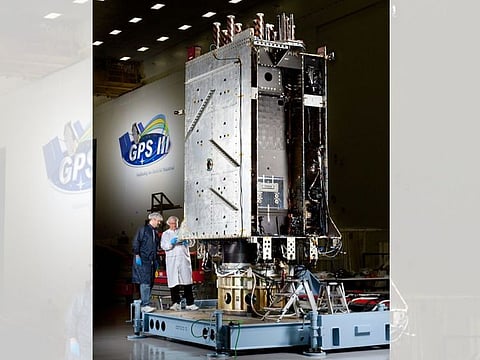GPS gets an upgrade: How it affects you, what happens next
With recent tech advances, efforts are underway to modernise the Global Positioning System

Highlights
- Known as GPS III, the third generation of ground stations and satellites, provides additional navigation signals for both civilian and military users — with a much higher accuracy and availability.
- Some tips on how you can make the most out of GPS III.
It’s a service we almost ignore today. But it's certainly something the great explorers like Amerigo Vespucci or Ferdinand Magellan could only have dreamt off. And it's right there at your fingertips, or your wrist.
The launch of the first global positioning system (GPS) satellite in 1978 has started a “geolocation” revolution.
Instead of relying on the stars to show our way around, GPS gear today do it in a manner that's never been done before. In the process, they turned manual compasses and lighthouses into postcard-perfect relics of the past.
Now, the GPS system just got an upgrade. In January, SpaceX’s Falcon 9 rocket launched the latest GPS Block III satellite into orbit, called Space Vehicle 06, named after the daring pilot Amelia Earhart.
Last week, SV06 received "operational acceptance" from the US Space Systems Command (SSC), which then transferred its Satellite Control Authority (SCA) to the 2nd Space Operations Squadron at Schriever Space Force Base in Colorado, according to Inside GNSS, an industry publication.
Billions of GPS users
Today's smartphones are more than just communication gear. They're gaming, banking, geolocation devices too, too. That means there are billions of GPS users like you and me.
The figures are quite mind-boggling: In 2021, there were 3.8 billion smartphones in use worldwide, according to Statista. An additional 1.7 billion were sold in 2022, which brings to the total to 5.5 billion smartphones — each with a tracking chip.
That number is set to jump further, to hit 18.22 billion by 2025. Today's smartphones are more than just communication devices; they're gaming, banking, geolocation gear too.
Smartphones form part of a nebulous number of tracking tools (including fitness watches, pet necklaces, dashcams, glasses, gaming devices, footwear, cars, trucks, bikes, helmets, and other such gear — there are more than 40 types of equipment fitted with tracking devices), numbering an estimated 15 billion in use today.
Each receiver gets a signal from the sky for “geolocation" — essentially, the use of IP addresses to identify | track connected devices.
When did GPS start?
The launch of the first GPS satellite took place in 1978, though it took several years for the system to become fully operational and available to civilian users.
So it took 40 years for GPS III, the third-generation service, to start its build-up, with the first satellite flown in 2018. Once completed, it will provide more accurate positioning, navigation, and timing services to users.
The first GPS III satellite, GPS III SV01 "Vespucci," was launched on December 23, 2018. The second GPS III satellite, GPS III SV02 "Magellan," was launched on August 22, 2019.
As of February 2023, a total of six GPS III satellites have been launched and are operational. Four more satellites are yet to be launched to complete GPS III.
Advantages of GPS Block III satellite system
Among the known advantages GPS III offers over its predecessors:
Improved accuracy: The Block III satellites have a more advanced atomic clock and a more powerful signal, which allows for greater accuracy in determining a user's location. For example, the GPS II systems have a 5–10 meter accuracy, but GPS III will have a 1–3 meter accuracy, allowing for an even more accurate "geolocation".
Enhanced cybersecurity: The Block III satellites feature advanced encryption capabilities and improved resistance to jamming and spoofing, which helps to prevent unauthorized access to the system.
Longer lifespan: The Block III satellites are designed to last longer than previous GPS satellites, reducing the frequency of costly replacements.
Increased capacity: The Block III satellites can transmit more signals at once, allowing for greater capacity and supporting more users simultaneously.
Interoperability: The Block III satellites are designed to be compatible with other global navigation systems, such as Europe's Galileo and Russia's GLONASS, enabling better global positioning and navigation capabilities.
How many GPS Block III satellites in service?
There are six GPS Block III satellites already in service (out of the 10 planned). The satellites are named after exploration pioneers: Vespucci, Magellan, Matthew Henson, Sacagawea, Neil Armstrong and Amelia Earhart.
To complete the constellation, the 4 other GPS-III satellites yet to be launched are:
Who builds the GPS III satellites?
According to the US Department of Defence, Block III satellites use Lockheed Martin's A2100M satellite "bus" structure. Each satellite carries eight deployable Joint Incremental Build (JIB) antennas — designed and made by Northrop Grumman Astro Aerospace.
JIB antennas
• JIB antennas are used to transmit and receive GPS signals to and from Earth-based GPS receivers. • The GPS III JIB antennas are designed to be more efficient and reliable than previous GPS antennas. They are composed of two types of antennas: the L1/L2 (GPS frequency) and L5 (newer GPS frequency) antennas. • The L1/L2 antennas are used to transmit and receive signals at the original GPS frequencies, while the L5 antennas are used to transmit and receive signals at a newer, more robust GPS frequency that is less prone to interference and jamming.
Tips on how to make the most out of GPS III:
These are some of the ways to make the most out of GPS III capabilities.
Sign up for the Daily Briefing
Get the latest news and updates straight to your inbox



